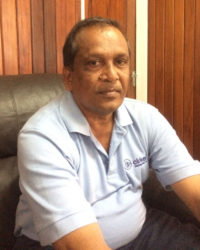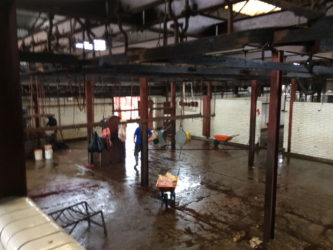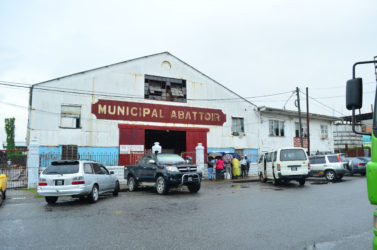While it will take millions of dollars to bring the dilapidated Municipal Abattoir up to standard, the
City Council is embarking on a phased upgrade of the facility.
Over the years, the abattoir, where the inspection and slaughter of bovine and porcine animals are conducted before the meat is released onto the market, has fallen apart. From the outside of the steel frame structure on Water Street, which has been in existence since 1933, window panes and materials used for the walls have been observed to be loose. In some instances, there are no windows panes, just the frame. On the inside, there are signs of deterioration, including rust.

City Hall Public Rela-tions Officer Debra Lewis had informed Stabroek News that plans were in the pipeline to have the abattoir brought up to modern standards. She explained that while it would take millions to rehabilitate the slaughterhouse, the council was preparing to do it in phases and would begin with the resurfacing of the floors. “We would not be able to do it all at once but we will start and move on from there,” Lewis said.
The challenges at the abattoir are many, but despite this, meat inspectors and other staff work assiduously to ensure that meat leaving there is fit for human consumption, Chief Meat and Food Inspector of the Georgetown Abattoir Deonarine Arjune said.

He highlighted some of the challenges, which hinder the staff’s efficiency. A priority issue is to have the floor resurfaced, he explained, while adding that the constant falling of bovine animals during the slaughtering process had created cracks and holes in the floor.
“We really need the floor to repair, in that way we would have better hygiene. With the cracks in the floor, pieces of meat would get stuck inside… and it is very hard to clean; the brooms’ bristles are eaten away… When this happens microorganisms grow there and we have all kinds of animals coming; some would be healthy and some would have diseases. If microorganisms are growing, then it defeats the purpose of having a sanitary abattoir,” he explained.

He noted that at every session they would slaughter animals weighing an average of 360 pounds. In some cases, they weigh over 800 pounds. With this in mind he said, he has advised the contractor that the cement mixture would have to be customised to ensure the floor can take the pressure of falling animals.
Lewis told this publication that the floor of the inspection and slaughtering chambers is expected to be resurfaced within weeks. “The health of the citizens is important to the municipality, so we are going ahead to start with the little resources we have,” Lewis stated.
Another issue highlighted by Arjune was the state of the gates securing some of the pens in the lairage, where animals are placed approximately 24 hours before being slaughtered. According to him, the gates of some of the pens are broken and the rails are missing.
“Butchers use other pens which are not assigned to them and this causes conflict between them. It is not easy to solve this problem because some would spend money to repair the pens that are already dilapidated,” he stressed. He recommended that the lairage also be furnished with a shed to protect the animals from harsh weather conditions and called on the council to work to address the issue at the lairage, which plays an integral part in the slaughtering of animals for consumption.
Rest
Arjune explained that if the animals are not properly rested it can result in poor quality of meat. “We have to let them rest and get accustomed to the environment. We do not give them food to eat while they are housed in the lairage, just water. If we feed them, we would have too much microorganisms on the meat and it can result in spoilage,” he explained.
Arjune also noted that prior to animals being slaughtered on Mondays, Wednesdays and Fridays, they undergo inspections by a registered veterinarian, who would greenlight the slaughtering. “But if the vet detects any abnormalities with the animal, he or she would indicate and we would not go ahead,” he explained, while adding that officers from the Criminal Investigation Department would also check the brands before giving the go ahead for animals to be slaughtered.
The abattoir is equipped with three different chambers for the slaughtering of animals: one for the Muslim faith and one for Christians and another for porcine animals.
Asked what method is being used to slaughter animals at the abattoir, Arjune explained that currently they tie the animals before sticking them or cutting their throats, a traditional method preferred by the Muslim faith.
He noted that it is recommended in accordance with international standards that a captive bolt gun be used to slaughter animals and one has been secured. However, they have not been able to practice this method as they are awaiting spare parts for the gun. “When we want the spring and packings, which is a part of the whole apparatus, we have to source it,” he said. He explained that they would have to make a request to a supplier, who would check the price and return with a quotation after which they would have agree on the purchase and then have it brought into the country.
Arjune noted that it is recommended that they have two captive bolt guns since it takes two minutes for a gun to recharge before it can be used again.
The captive bolt gun method of killing is described as a more humane approach to slaughtering animals since a single stun shot in the head prevents the immense pain the animals suffer during the current process, and it also results in a faster death.
Other issues highlighted by Arjune are the lack of cold storage and lack of a laboratory. If these were in place, he explained they would be able to function more effectively. “The cold storage would help us to identify if there is any sickness or disease in the meat,” he said.
He also stressed the need for a new heating system at the abattoir. He recommended that an industrial heating system be installed as a part of renovation for the tripery section. “This is the area where we prepare the heel, the tripe, the face and runners. An industrial heater would help us to get ready access to hot water because right now, they use a fireside and sometime the wood gets wet,” he explained.
The entire section, he noted, is also in dire need of plumbing fixtures. He expressed the hope that the council would be able to make finances available to have the abattoir renovated.
He added that over the years, the equipment they use, such as the scale to weigh animals, has deteriorated but remains functional.
Meanwhile, Arjune said that while they work to maintain standards, they are challenged by meat coming into Georgetown. He said when meat arrives, on many occasions they are unable to check its quality and if it carries any diseases, since the carcass is cleaned and parts are discarded in out-of-town communities. “You see, we can’t check them… so we don’t know if they had diseases or not and it is a major challenge for us,” he said.
In this regard he suggested that a system be put in place. “If persons decide that they want to supply people in the city, it is recommended that they slaughter at the abattoir. In that way we can be able to inspect the meats thoroughly,” he stated.




